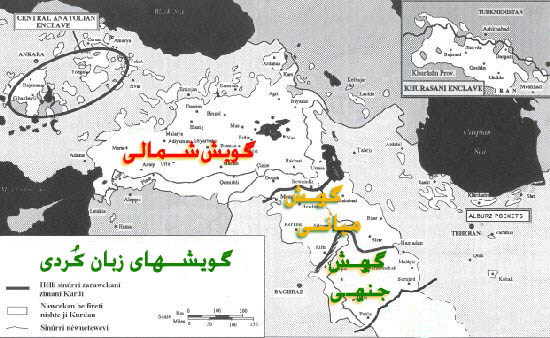On the merits of denoting the Kurdish phoneme /é/ (as ea in ére) by an acute accent /é/ rather than a circumflex /ê/.
On the merits of denoting the Kurdish phoneme /é/ (as ea in ére) by an acute accent /é/ rather than a circumflex /ê/.
On the merits of denoting the Kurdish phoneme /é/ (as ea in ére) by an acute accent /é/ rather than a circumflex /ê/.
One basic premise in KAL’s adopted phonetic system has been the way by which the Kurdish language is functions as a whole and the fact that the common ground for all Kurdish dialects has been phonetic rather than orthographic. The following illustration depicts the contributing percentage of various Kurdish dialects to the creation of a Kurdish Unified writing system. This system is to be based on the current writing practices whether Latin, Cyrillic or Arabic based.

The Kurdish Unified Writing System contains 3% new elements and 19% adjusted adaptations. This strategy is justified by the rules governing the global standardization (ISO-8859-1) and the goal of representing Kurdish Language as a single independent language via a single writing system.
Most of the pioneer attempts in codifying Kurdish orthography were led by factors such as religion, language skills of the individuals, and reflection of neighbouring countries official languages (Arabic, Turkish, Persian), rather than the independent character of Kurdish Language.
The goal here is not to justify how certain letter may sound in a given European language. KAL undertakes this task via the creation of a solid framework that put the linguistic functions of Kurdish language into a system that conforms to the International Standards.
Consequently, the adoption of the acute accent and circumflex diacritics are simple adjustment for use by the current IT keyboard system. It is also intended to keep the alphabet system functional in the framework of ISO-8859-1, requiring no engineering efforts, leading to its wide acceptability. This particular point is more in the domain of the computer and IT engineering than that of the linguists. On the other hand depending on the Kurdish dialect, level of stress for [é] might change significantly.
Every effort has been made to use the core experience of writing in Kurdish in any form (see the above illustration). KAL emphasises that it is not the orthographic representation which is important in this creation but the experience of writing practice in any Kurdish alphabet system. Kurds need to have a radical reform in their writing at a time when more than half of us are illiterate or semi-literate. We need to focus on new educational system for the new learners. The Kurdish Language needs to play its role as a unifying tool as much a communication medium. We need to see a Kurdish Unified Writing System for posterity.
- 12486 reads
- پارسی



